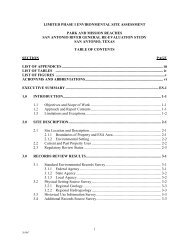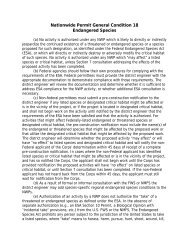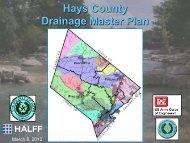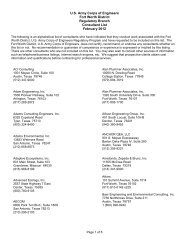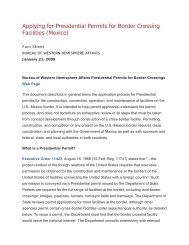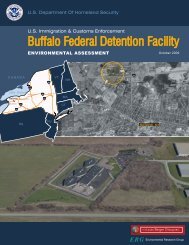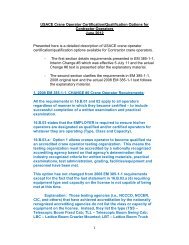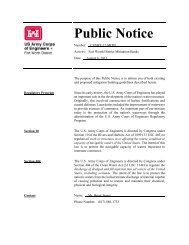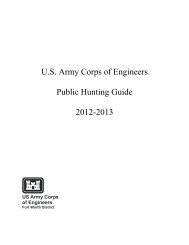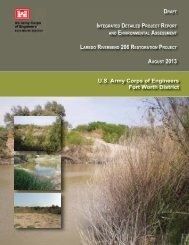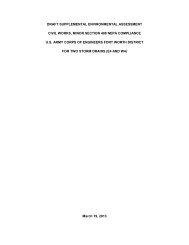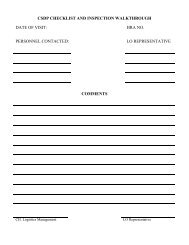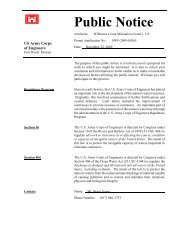environmental assessment us border patrol, tucson sector
environmental assessment us border patrol, tucson sector
environmental assessment us border patrol, tucson sector
You also want an ePaper? Increase the reach of your titles
YUMPU automatically turns print PDFs into web optimized ePapers that Google loves.
3-261234567891011121314151617181920212223242526272829303132333435363738394041424344454647construction; and incorporation of post-construction stormwater controls that minimize longtermimpacts on surface waters and allow for groundwater recharge.Therefore, the Preferred Alternative may affect the beautiful shiner, Yaqui catfish, and Yaquichub, but would not likely adversely affect these species due to the control of sedimentation andrunoff from the FOB site and the distance removed from known habitat for these species.Project-specific design measures have been included to ensure that potential impacts on thebeautiful shiner, Yaqui catfish, and Yaqui chub are extremely unlikely to occur and arediscountable. Likewise, no adverse modification of beautiful shiner, Yaqui catfish, or Yaquichub Critical Habitat would occur.Although several state-listed species could potentially occur at the Preferred Alternative site,none were observed during the biological survey. However, the Preferred Alternative wouldpermanently alter approximately 10 acres of desertscrub habitat to developed hardscape andlandscaped areas. The Chihuahuan desertscrub habitat present at the site for state-listed speciesis both locally and regionally common, and the permanent loss of 10 acres of habitat would notadversely affect the population viability or fecundity of any state-listed species in the region.3.7.2.3 Alternative 2No Federally or state-protected species are expected to occur at or near the Alternative 2 site forthe same reasons described for the Preferred Alternative. Therefore, impacts from thedevelopment of the proposed FOB on approximately 10 acres under Alternative 2 would besimilar to those disc<strong>us</strong>sed for the Preferred Alternative.3.7.2.4 Alternative 3No Federally or state-protected species are expected to occur at or near the Alternative 3 site forthe same reasons disc<strong>us</strong>sed for the Preferred Alternative. Runoff from the Alternative 3 sitewould not enter into Black Draw; however, the site would drain to Hay Hollow Wash (see Figure3-2), which could also potentially provide habitat for listed fish species near the <strong>border</strong>. Themeasures disc<strong>us</strong>sed under the Preferred Alternative would also be implemented underAlternative 3. Th<strong>us</strong>, impacts from the development of the proposed FOB on approximately 10acres under Alternative 3 would be similar to those disc<strong>us</strong>sed for the Preferred Alternative.3.7.2.5 Alternative 4No Federally or state-protected species were observed during the biological survey at theAlternative 4 site. While potentially suitable habitat exists at the site for Cochise pinc<strong>us</strong>hioncact<strong>us</strong> and lesser long-nosed bat, no evidence of either species was observed during the May2011 biological survey.Although potentially suitable habitat for the Cochise pinc<strong>us</strong>hion cact<strong>us</strong> is present at theAlternative 4 site, no cacti were observed; and no disturbance of the rocky ridge would occur aspart of Alternative 4. Therefore, CBP has determined that no adverse effect on the Cochisepinc<strong>us</strong>hion cact<strong>us</strong> would occur.Potential lesser long-nosed bat day roosts were observed on the undeveloped, rocky ridge on theeastern portion of the Alternative 4 site during the May 2011 surveys, but no bats or guano wereseen during the biological survey. Moreover, no disturbance of the rocky ridge would occur asDouglas FOB EADraftAug<strong>us</strong>t 2011



